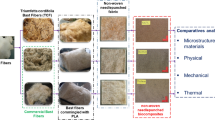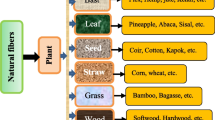Abstract
With increasing limitation of petrochemical resources, there is a growing demand for the replacement of nonrenewable fiber-reinforced polymer composites by renewable polymer composites. Therefore, the aim of this research work was to improve the mechanical properties of bast (plant) fibers reinforced polymer composites without reducing their renewable material content. To achieve this goal, basalt fibers (natural mineral fibers) were used to partially substitute the amount of bast fibers in the polymer composites. The applied fibers were processed to semi-finished materials by carding and needle punching and processed further by afterwards press-molding. An intense optimization of the carding process led to the production of homogeneous fabrics based on various types of fibers (bast, basalt and PP). The homogeneity of the fabrics was confirmed by scanning electron microscopy (SEM) analysis of the composites. Several composites based on polypropylene and acrylate thermoset resin, reinforced with merely bast fibers, were prepared as reference. In the next steps, the bast fiber content of the reference compositions was partially replaced by basalt fibers. The compression-molded samples were tested for their flexural, tensile, and impact energy properties. The very positive finding was that the addition of basalt fibers not just improved significantly the strength and stiffness of the composites, but simultaneously increased the properties of the composites regarding energy absorption, a key requirement in the automotive industry. The fracture surface analysis confirmed a better fiber matrix adhesion in thermoset composites compared to thermoplastic composites. The tested renewable hybrid polymer composites have great potential to replace nonrenewable fiber-reinforced polymer composites.













Similar content being viewed by others
References
Carus M, Barth M (2015) Nova carbon footprint and sustainability of different natural fibres for biocomposites and insulation material. Hürth
Holbery J, Houston D Natural fiber reinforced polymer composites in automotive applications. JOM 11:80–86
Medina L.A, Dzalto J (2018) 1.11 Natural Fibers. Comprehensive Composite Materials II: 269–294
Anand P, Rajesh D, Kumar SK (2018) Investigations on the performances of treated jute/Kenaf hybrid natural fiber reinforced epoxy composite. J of pol res 25:94
Wang J, Wang W, Wu W (2011) Preparation and characterization of hemp hurd powder filled SBR and EPDM elastomers. J of pol. res. 18: 1023–1032
Pierre J, Sojoudiasli H, Heuzey M, Carreau PJ (2014) Rheological, morphological and mechanical properties of flax fiber polypropylene composites: influence of compatibilizers. Cellulose. 21:3797–3812
Notta-Cuvier D, Lauro F, Bennani B (2016) Impact of natural variability of flax fibres properties on mechanical behaviour of short-flax-fibre-reinforced polypropylene. J of mat.Sci 56:2911–2925
Riedel U (2007) NF-Werkstoffe - Aktuelle anwendungen und perspektiven. DGM-Tagung, Bremen
Biagiotti J, Puglia D, Kenny JM (2004) A review on natural fibre-based composites-part I. J of nat fib 1:37–68
Mohanty AK, Misra M, Hinrichsen G (2000) Biofibres, biodegradable polymers and biocomposites: an overview. Macromol mater and eng 1:1–24
Mohanty AK, Misra M, Drzal LT (2002) Sustainable bio-composites from renewable resources. J of polym and environ 10:19–26
Haq M, Burgueño R, Mohanty AK, Misra M (2009) Processing techniques for bio-based unsaturated-polyester/clay nanocomposites: tensile properties, efficiency, and limits. Composites Part A: App sci and manufact 40:394–403
Shubhra QTH, Alam A, Quaiyyum MA (2013) Mechanical properties of polypropylene composites. J of thermoplast composite mat 26:362–391
Nimanpure S, Hashmi S, Kumar R, Bhargaw HN, Kumar R, Nair P, Naik A (2017) Mechanical, electrical, and thermal analysis of sisal fibril/kenaf fiber hybrid polyester composites. Polymer comp 28:2175–2184
Salleh F, Hassan A, Yahya R (2014) Improvement in the mechanical performance and interfacial behavior of kenaf fiber reinforced high density polyethylene composites by the addition of maleic anhydride grafted high density polyethylene. J of polym res 21:439
Dittenber DB, GangaRao HV (2012) Critical review of recent publications on use of natural composites in infrastructure. Composites Part A: Applied sci and man 43:1419–1429
Santulli C (2007) Impact properties of glass/plant fibre hybrid laminates. J of mat sci 42:3699–3707
Sathishkumar TP, Naveen J, Satheeshkumar S (2014) Hybrid fiber reinforced polymer composites – a review. J of reinf plast and comp 33:454–471
Petruccia R, Santulli C, Puglia D, Nisini E, Sarasini F, Tirillo J, Torre L, Minak G, Kennya M (2015) Impact and post-impact damage characterisation of hybrid composite laminates based on basalt fibres in combination with flax, hemp and glass fibres manufactured by vacuum infusion. Comp. Part B: Eng. 69:507–515
Petruccia R, Santulli C, Sarasini F, Puglia D, Torrea L, Kenny J (2013) Mechanical characterisation of hybrid composite laminates based on basalt fibres in combination with flax, hemp and glass fibres manufactured by vacuum infusion. Mater Des 49:728–735
Kim H (2013) Enhancement of thermal and physical properties of epoxy composite reinforced with basalt fiber. Fib and polym 14:1311–1316
Lopresto V, Leone C, Iorio ID (2011) Mechanical characterisation of basalt fibre reinforced plastic. Compos Part B 42:717–723
Wei B, Song S, Cao H (2011) Strengthening of basalt fibers with nano-SiO2–epoxy composite coating. Mat & Design 32:4180–4186
Matykiewicz D, Barczewski M, Knapski D, Skórczewska K (2017) Hybrid effects of basalt fibers and basalt powder on thermomechanical properties of epoxy composites. Composites Part B: Eng 125:157–164
Soares B, Preto R, Sousa L, Reis L (2016) Mechanical behavior of basalt fibers in a basalt-UP composite. Proced struct integ 82-89
Fiorea V, Scalicia G, Bellab G, Valenzaa A (2015) A review on basalt fibre and its composites. Comp Part B: Eng 74:74–94
Singha K (2012) A short review on basalt Fiber. Int J of text sci 4:19–28
Dorigato A, Pegoretti A (2014) Flexural and impact behaviour of carbon/basalt fibers hybrid laminates. J of comp mat 48:1121–1130
Sarasini F, Tirillò J, Valente M, Valente T, Cioffi S, Iannace S, Sorrentino L (2013) Effect of basalt fiber hybridization on the impact behavior under low impact velocity of glass/basalt woven fabric/epoxy resin composites. Comp Part A: Appl sci and man 47:109–123
Deák T, Czigány T (2009) Chemical composition and mechanical properties of basalt and glass fibers: a comparison. Text Res J 79:645–651
Fiore V, Scalici T, Calabrese L, Valenza A, Proverbio E (2016) Effect of external basalt layers on durability behaviour of flax reinforced composites. Comp Part B: Eng 84:258–265
Fiorea V, Scalicia T, Badagliacco D, Enea D, Alaimo G (2017) Aging resistance of bio-epoxy jute-basalt hybrid composites as novel multilayer structures for cladding. Comp str 160:1319–1328
Czignay T, Vad J, Pölöskei K (2005) Basalt fibers as reinforcement of polymer composites. Per Polytech SerMechEng 49:3–14
Matko S, Anna P, Marosi G, Szep A, Keszei T, Pölöskei K (2003) Use of reactive surfactants in basalt fiber reinforced polypropylene composites. Macromol Symp 202:255–267
Botev M, Betchev H, Bikiaris D, Panayioto C (1999) Mechanical properties and viscoelastic behavior of basalt fiber reinforced polypropylene. J of app poly sci 74:523–531
Nayak SK, Mohanty S, Samal SK (2009) Influence of interfacial adhesion on the structural and mechanical behavior of PP-banana/glass hybrid composites. Polym Compos 41:1247–1257
Sakthivel M, Vijayakumar S, Ramesh S (2014) Production and characterization of Luffa/coir reinforced polypropylene composite. Procedia Mater Sci 5:739–745
Biswal M, Mohanty S, Nayak SK (2011) Mechanical, thermal and dynamic-mechanical behavior of banana fiber reinforced polypropylene nanocomposites. Polym Compos 32:1190–1201
Müssig J (2010) Industrial application of natural fibres. Wiley, Chichester
Mueller D (2003) New discovery in the properties of composites reinforced with natural fibers. J of Indust Text 33:111–130
Rymsza TA (2000) Advancements of Kenaf in USA-Kenaf paper and non paper developments. In: International kenaf conference, Japan
Quazi TH, Alam A, Quaiyyum M (2011). J of Thermoplast Comp Mat 26:362–391
Khallafa M, Marcel V, Duval A, Abbes B (2014) Flax/Acrodur® sandwich panel: an innovative eco-material for automotive applications. JEC comp magaz 89:73
Mohanty AK, Drzal LT, Misra M (2005) Natural fibers, biopolymers, and biocomposites. Taylor & Francis, Boca Raton
Boss H, van de Oeven M, Molenveld K (2004) Influence of fiber structure on composite properties. 5th global wood and natural fibre composite symposium, Kassel
Medina L (2007) Dissertation, Institute für Verbundwerkstoffe, Kaiserslautern
Acknowledgements
Authors would like to thank the company J. Dittrich & Söhne Vliesstoffwerk GmbH for supplying the bast fibers as well as the thermoset resin. Many thanks to the company Fibtex GmbH and Beaulieu International Group, Belgium for providing basalt and polypropylene fibers, respectively. Special thanks to Prof. Schuster, at University of Applied Sciences, Kaiserslautern for providing his lab facilities for mechanical analysis. Finally, we would like to thank the Institute für Verbundwerkstoffe GmbH in Kaiserslautern for providing the SEM pictures of the composites.
Author information
Authors and Affiliations
Corresponding author
Additional information
Publisher’s note
Springer Nature remains neutral with regard to jurisdictional claims in published maps and institutional affiliations.
Rights and permissions
About this article
Cite this article
Saleem, A., Medina, L. & Skrifvars, M. Mechanical performance of hybrid bast and basalt fibers reinforced polymer composites. J Polym Res 27, 61 (2020). https://doi.org/10.1007/s10965-020-2028-6
Received:
Accepted:
Published:
DOI: https://doi.org/10.1007/s10965-020-2028-6




